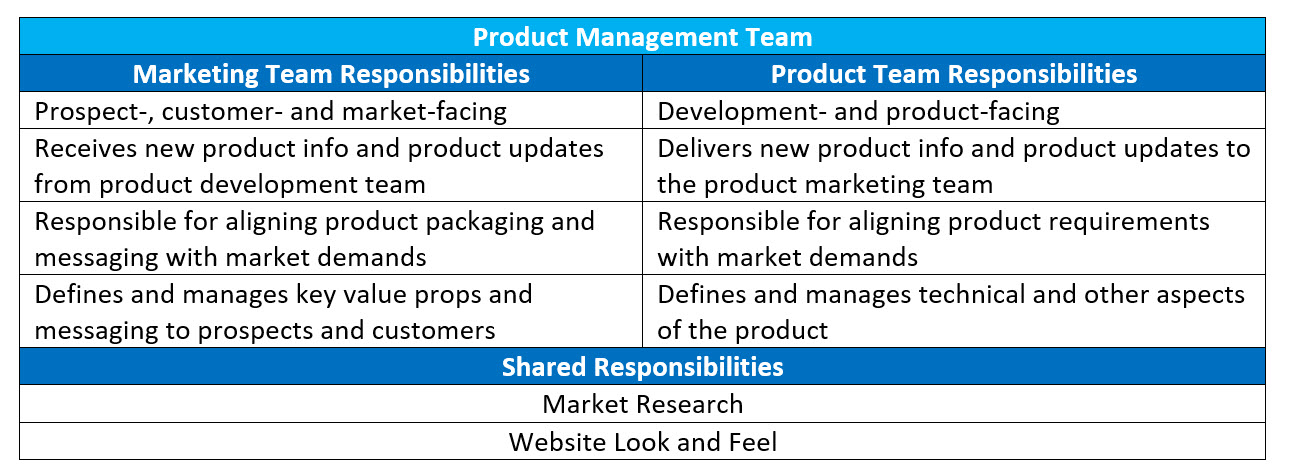Is your organization more ‘IWBITWC’ or ‘ASNS'? How to balance marketing and product teams to build long-term success.
 Marketing and product are different but complimentary teams in any business. As an employee and now as a consultant, I’ve seen first-hand how the balance between them can help or hinder an organization. Read on to learn how to determine whether your company leans more toward marketing or product, and how to create the balance you need for long-term success.
Marketing and product are different but complimentary teams in any business. As an employee and now as a consultant, I’ve seen first-hand how the balance between them can help or hinder an organization. Read on to learn how to determine whether your company leans more toward marketing or product, and how to create the balance you need for long-term success.
The two extremes between marketing and product
1. If we build it, they will come (IWBITWC)
An IWBITWC organization lets the product team take the lead and places little importance on marketing. If there is a marketing team, they likely lack a VP or C-level role in the organization. Often there is no marketing team at all, or a team with marketing in their title but little traditional marketing expertise.
These types of organizations can have success, but it often limits their growth at some point. A well-developed product can garner a niche fan base but expanding outside of this group to gain broader recognition and expand the customer base takes marketing.
2. All style, no substance (ASNS)
An organization that is ASNS places a heavy emphasis on marketing, while relegating product to an ancillary role. It’s all smoke and mirrors – there’s no ‘there’ there. The product team may report up through marketing or may be non-existent.
These types of organizations an also be successful, but as time goes on the marketing will have to be more and more successful to make up for the lack of a strong product. Often these organizations are good at getting new customers but struggle to retain existing ones.
Which way does your organization lean?
Every organization leans toward either marketing or product – and that’s okay. The key to success is keeping the balance between the two somewhat close. When one greatly outweighs the other, that’s when you run into problems.
So how do you create balance? The first key is to understand the responsibilities of each functional team and how to make them work together. Here’s an overview:

Organizations which aren’t balanced often have the wrong team handling some of the responsibilities listed above. This is where issues arise that can impact a company’s ability to grow – or even to survive.
How does this impact email?
 If I told you that the email contained an explicit marketing call-to-action, like ‘sign up for a free trial now,’ you’d probably agree that it should be created, managed and owned by the marketing team. And there are good reasons for this, beyond the chart above.
If I told you that the email contained an explicit marketing call-to-action, like ‘sign up for a free trial now,’ you’d probably agree that it should be created, managed and owned by the marketing team. And there are good reasons for this, beyond the chart above.
Professionals trained in this type of direct-response marketing know how to craft a message that leverages features, benefits and advantages to persuade readers to act. They would know they had to make the case for a free trial, to give people a reason to want a free trial, not just offer it and hope that some recipients respond.
An experienced marketer would also know that one message is likely not enough and would develop a series of emails to drive the reader to action – or at least do strategic resends of the single message. A strategic marketer would look at the whole journey from prospect to customer (and perhaps beyond) and develop an email marketing program to move people through from start to finish. They would know that this isn’t just about one email or getting someone to sign-up for a free trial. This is about converting prospects to customers.
No brainer, right? Well how about this one.
What if the email was being sent to prospects participating in the trial as well as to customers, alerting them to a new feature of the product?
The content of the email is about the product, no question there. But it is being sent to prospects and customers – it’s prospect- and customer-facing. Therefore, it resides in the marketing department. The product team can and should provide background on features – even better if they can give the marketing team a start on benefits and competitive advantages. But it’s the marketing team that should create, manage and own the email message.
It’s these types of messages where some organizations falter. Sometimes it’s because the product team is territorial and doesn’t want to give up any ‘turf’ to marketing. Other times it’s because C-level management doesn’t really understand or value marketing as a function. Many times, the latter is what causes the former. The longer this goes on the more the organization will lean toward product and away from marketing – and the more difficult it will be to right the ship.
How can you correct an imbalance between marketing and product development?
 If your organization leans heavily toward product then hiring a strong chief marketing officer (CMO) is a good start; if you’re leaning toward marketing than you need a strong chief product officer (CPO). But just adding to the C-suite is not enough. You also need to look at activities, attitudes, personnel and performance.
If your organization leans heavily toward product then hiring a strong chief marketing officer (CMO) is a good start; if you’re leaning toward marketing than you need a strong chief product officer (CPO). But just adding to the C-suite is not enough. You also need to look at activities, attitudes, personnel and performance.
Activities: Look at everything that is being done in the marketing, product and related realms (user experience, taxonomy, etc.) and determine whether the activity is being handled by the right group. The easiest way to do a first cut on this is to determine whether they are prospect-, customer- and market-facing (marketing) or development- and product-facing (product).
Attitudes: Understand how people within your organization think about marketing and product – and help them see that both are integral parts of a successful company. The IT folks don’t need to be able to write product specs or draft an effective marketing plan, but they should understand the value that each function brings to the table.
Personnel: Evaluate everyone on the marketing, product and related teams to determine where their true expertise lies. It’s not unusual to find some people on the product team who are natural marketers; it’s also often true that some of those in the marketing department are better suited to product roles.
Performance: Analyze your marketing initiatives to determine which are successful and which are not. There’s a good chance that ineffective marketing initiatives have mistakenly been placed under product’s control. On the flip side, if your product development initiatives are what’s faltering, then make sure that the team managing them truly has expertise in that area.
All of this can be difficult to do from the inside; asking the same people and forces that caused the imbalance to acknowledge it and create change to correct it is a tall order.
Fresh eyes, in the form of a team of outside consultants or a task force comprised of members of the board is often needed. You will also need a strong chief executive officer (CEO) to support the decision and win (with carrots or with sticks, whichever works) hearts and minds. So is patience, and the ability to live through some discomfort while the ship is being righted – and understanding that a company without a strong balance between marketing and product is limiting itself and its ability to be successful over the long term.

 How to resolve AdBlock issue?
How to resolve AdBlock issue? 